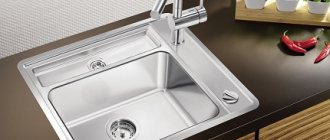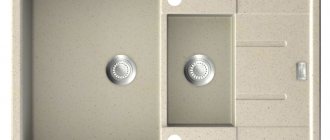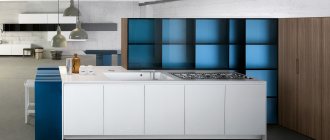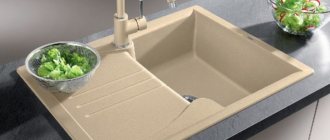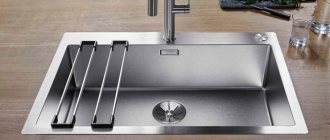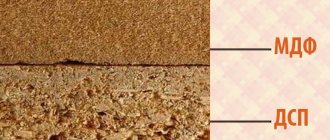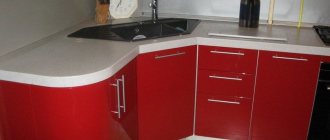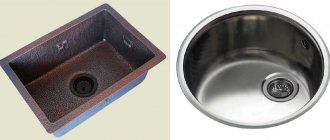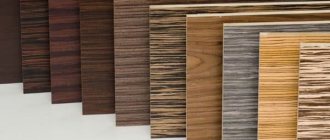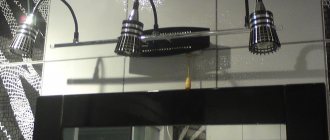Every housewife has to deal with washing dishes in the kitchen every day, which is sometimes a tedious task. To ensure that the process does not cause inconvenience, you need to carefully consider all the nuances in the work area, making the place for the sink and the sink itself as comfortable and practical as possible.
Read further in the article about what nuances you should know and take into account when choosing a durable, comfortable sink that matches the style of your interior.
Kinds
The construction market offers dozens of sink options, ranging from appearance, manufacturing materials, modifications, to suit every taste and budget.
The shape of the bowl is:
- round;
- oval;
- trapezoidal;
- square;
- rectangular.
Based on the installation method, they are divided into the following models:
- invoices;
- mortise;
- integrated;
- under-table.
Based on the material used, the following types of kitchen sinks are distinguished:
- stainless steel;
- ceramic (enamel);
- from natural and artificial stone.
Different product shapes: how to choose the right geometry
The shape of the product is classic, that is, rectangular and square, as well as round geometry in the form of an oval or circle. The classic type of sinks is more common because it is practical, can be of any size, with different designs. Round sinks are relevant for modern styles; they will fit perfectly into the corner of the layout, but their dimensions must be roomy.
Advice! If you have a small kitchen and you have to wash a lot of dishes, then it is better to refrain from installing a small round sink on it. During operation, pans with long handles may not fit into the sink if the size of the sink is small.
Criterias of choice
It is advisable to purchase a sink at the stage of planning the design of the kitchen unit. Decisive factors for the right choice:
- Modification. The sink can be corner or straight, with one or several bowls, with or without a wing.
- Colors. It is desirable that the color of the sink matches the shade of the countertop and fits harmoniously into the overall design of the kitchen.
- Shape and capacity of the bowl. If you have to wash dishes frequently, including tall pots, the sink should be deep.
- Installation method. Built-in, integrated sinks are designed for the countertop. For an isolated cabinet with a sink, an overhead option is suitable.
- Price. If your budget is limited, you can purchase a stainless steel or ceramic sink. When price does not matter, models made from expensive raw materials or with additional accessories are suitable.
A competent approach to choosing a design solution for a sink
There are sink models equipped with more than one bowl. There may be two, three or more. Of course, this is very convenient, because you can wash vegetables in one, dishes in another, and defrost food in a third. The question is whether such a structure will fit in your space. Therefore, base your choice on the area of the room.
Material of manufacture
The service life, appearance of the kitchen sink, price, variety of models and other characteristics depend on this indicator. Let's take a closer look at the different options.
Stainless steel
Such bowls are made from chromium-nickel alloy. They fit well into kitchens of different design styles. The surface can be smooth, glossy or matte, rough. The latter option is less susceptible to scratches, but costs a little more.
Advantages of a stainless steel sink:
- affordable price;
- wide selection of models and sizes;
- durability;
- light weight;
- easy cleaning;
- corrosion resistance.
Minuses:
- when a stream of water touches the bottom, a loud noise is created;
- There is only one color option;
- appearance of scratches on the surface.
The stainless steel kitchen sink is made from a single sheet of metal, without welds. The thickness of the material also matters: from 0.12 to 3 mm. The higher this indicator, the stronger the sink and the more expensive the price.
Expert opinion
Olga Kovalenko
Since 2010 I have been engaged in interior design and architectural design.
To check that the sink is really made of stainless steel, just attach a magnet to the surface.
Ceramic (enamel)
The basis of the product is earthenware or porcelain, or metal, cast iron. The top enamel coating is hard and smooth, does not scratch and is not susceptible to chemical influences or temperature changes. These sinks are available in different shades and fit harmoniously into rustic and retro interiors.
Pros of ceramic sinks:
- scratch resistance;
- hygiene;
- ease of care.
Minuses:
- short service life;
- fragility of the top coating.
Made from artificial stone
These models are made from granite, marble chips, quartz sand, acrylic resins, a mixture of minerals and polymers. Their surface looks presentable, looks like natural stone, and has good performance characteristics.
This type of kitchen sinks has been popular in recent years, thanks to its stylish design, it fits into interiors of different styles.
Advantages of artificial stone sinks:
- affordable price;
- no noise from the water jet;
- variety of models and colors;
- easy care;
- impact resistance.
Minuses:
- formation of indelible stains;
- The use of abrasive cleaning agents is prohibited.
Made from natural stone
These are expensive luxury models that look presentable and are usually used in luxury interior designs. Products are made by hand from marble, onyx, basalt, granite, travertine. Often, a kitchen sink made of stone is a single composition with a countertop.
Pros of a stone sink:
- has a unique pattern;
- strength and durability.
Minuses:
- high price;
- complexity of installation;
- coloring matter “eats” into the surface and can only be removed by sanding;
- This bowl requires delicate care.
Combine with your chosen design style
The color scheme depends on the style in which the kitchen is decorated. The more modern and extravagant it is, the brighter the color scheme:
- Provence - light green shell;
- high-tech - red mars, terracotta, metallic;
- pop art - yellow;
- minimalism - white, beige or metal;
- loft - gray, black or white;
- modern - cream, graphite;
- classic - “frost”.
Matte shades of any rich colors look great. If the household has a dishwasher, you can install a sink in a delicate pastel shade.
Designs, shapes and depths
From a practicality point of view, the larger and wider the bowl, the better. However, there is not always enough space on the countertop to install such sinks. Experts recommend installing the sink in such a way that there is at least 5 cm from the outer border to the wall. The permissible depth is from 16 to 26 cm.
It is important to decide in advance on the mixer model. For a shallow bowl, you need a high tap, otherwise it will be problematic to slide the pan under the running water.
The shape of the bowl plays a special role in practicality. Round and oval sinks are stylish, but they have a harder time holding as many dishes as square and rectangular ones. Trapezoid-shaped sinks are installed in the corner of the kitchen unit. For non-standard design ideas, asymmetric models are chosen.
The design of sinks may vary:
- one or two wings (platforms for placing dishes);
- additional bowls (same volume or smaller);
- extended rim for mixer tap with round hole.
Sink forms
Modern models amaze with their variety of shapes. Manufacturers produce standard options in the form of a circle and rectangle. There are other shapes of sinks: triangular, asymmetrical, etc.
Classic types are used more often to equip the kitchen space. Buyers are attracted to them by their affordable price and ease of installation. They are easier to care for.
Over time, the question may arise about how to clean the sink. The drainage system has a simple structure, so after determining the cause of the problem, you can begin to remove the blockage.
There are sinks with two or more bowls. Functional products allow you to simultaneously wash dishes and vegetables, separate metal utensils and fragile objects. The more intricate the shape of the product, the more difficult it is to maintain impeccable cleanliness every day.
Dimensions
Compact sinks have dimensions from 45x45 cm. Large standard sinks are 60x100 cm. You can also make custom-made sinks of various sizes and modifications.
As a rule, the larger the volume of the bowl, the wider the wings for drying dishes. In small kitchens, compact round or square sinks are often installed, but deep. When calculating the space for a future sink, its external boundaries are taken into account.
Corner models help save space, but before installing such a sink, you should make sure that you don’t have to stretch or bend too much when washing dishes.
When choosing a sink, it is important to consider the size of the cabinet located under the bowl. Its dimensions should be such that the sink can be installed in the middle, within the boundaries of the vertical walls.
How to install
Mostly, professionals install stone sinks. This is due to the fact that sinks are often mounted on a countertop made of the same material, and the process itself is complex. Specialists not only install the product correctly, but also make sure that the seams between the sink and the work area are completely invisible.
It is not recommended to carry out installation yourself in such cases.
If you decide to install a stone sink in a regular countertop, you can do it yourself. All that is required from the master in this case is to follow the step-by-step instructions.
The first step is to cut a hole to fit the size of the sink. Standard options include overhead sinks 60x60 cm. At this stage, you need to draw an outline to create a hole. To make all the markings correctly, it is best to use a template made of cardboard or paper.
A jigsaw is used to create the hole.
After this, you need to process the edge using a sealant for this purpose. Often a special sealing tape is mounted on this part, which is also convenient. At the same stage, you need to process the perimeter from the top side.
After this, the sink is slowly and carefully mounted into the countertop, using special screws to secure the product. They are fixed on the bottom.
After installing the sink, you need to work on the faucet. It is fixed on the sink, and then connected to the water pipes. A siphon is connected to the drain hole.
At the final stage, the remaining sealant is removed. After this, the sink will be ready for use.
Additional items and accessories
For operation, you should choose a sink with auxiliary elements, such as:
- tap for a separate bowl;
- automatic valve;
- filters for water purification;
- overhead grilles.
These devices make the everyday process of preparing dishes, washing dishes and food easier, and help save countertop space. For expensive models, manufacturers add accessories designed for a specific model and color.
Expert opinion
Olga Kovalenko
Since 2010 I have been engaged in interior design and architectural design.
Typically you have to purchase a sink faucet separately, but its design must match the sink. So, a metal faucet is suitable for stainless steel, and for stone - with a similar decorative coating. Chrome faucets are considered universal and can be combined with different materials.
Sink under the window in the kitchen: advantages and disadvantages
Like any design decision, relocating a sink has its advantages and disadvantages. They must be known before starting work. This will help you avoid stressful situations and carefully plan the entire repair process. So, the advantages of washing under the window are the following:
- A universal option for kitchens in a variety of styles. Most often, a sink under a window can be seen in a classic, country, or loft style.
- Beautiful view outside the window. Agree, washing dishes while looking at a beautiful park or pond is much more pleasant.
- Increased work space. This advantage will be provided if the level of the window sill coincides with the tabletop. This way you will have much more space to work with.
- Due to the location of the sink near the window, you will have to use electricity much less often. And this will already help reduce monthly expenses.
- After the remodel, there will be more space for additional cabinets. This is especially true for a small kitchen.
Of course, this solution also has many disadvantages:
- the complex process of moving and installing a sink. This is especially true if the height of the working surface and the window sill are different. Often such manipulations require additional approval.
- Window frames deserve special attention. Please note that in this case it is better that they are not wooden. Because moisture can accumulate on them in everyday life. As you know, it negatively affects all wooden surfaces. An alternative solution could be double-glazed windows with plastic frames. It is resistant to water and retains more heat in the room.
- It is very important to choose the right faucet so that the window sashes open wide. Otherwise, there will be problems with ventilation of the room.
- Often, with this arrangement, frames and windows fog up, so mold may develop over time. To avoid this, you can install a ventilation grill directly in the countertop.
Installation methods
The sink should be selected not only based on the design of the kitchen unit, the size and modification of the cabinets, but also on the installation method.
There are sinks:
- Mortise. The bowl is lowered into a pre-cut hole of a suitable size. The upper parts are sides, wings are placed on the tabletop.
- Integrated. They are usually made together with a set and installed flush, flush with the tabletop and visually forming a solid structure.
- Invoices. These sinks cover the top of a small cabinet. Suitable for modular, free-standing models. Most often they are made of stainless steel.
- Under-table. Models to order. Such a sink is rarely installed in the kitchen, in exclusive designs made of stone. Such bowls are usually installed below the level of the countertop.
Integrated Products
Such sinks are more difficult to install, so professional help is required. Visually they look like a single unit with the countertop. A beautiful and original product will decorate your kitchen. Such sinks are valued for their variety of shapes and colors.
Monolithic models are easy to care for, as there are no seams or sides. The main disadvantage of integrated sinks is the high price.
Price
The price of a kitchen sink consists of several components, but the type of raw materials used is decisive. However, high cost is not always an indicator of durability or quality.
Thus, the usual stainless steel can last longer than a stone sink, but cost an order of magnitude less. You have to overpay for a stylish appearance, configuration, additional accessories, and the reputation of the manufacturer.
The price range for a sink made from a certain material can vary significantly. Thus, budget stainless steel in the construction market costs no more than 2 thousand rubles, and in an elite plumbing showroom it costs 30-50 thousand.
Products can be arranged in the following order in ascending order of average prices:
- ceramic – 1-3 thousand rubles;
- stainless steel – 2-6 thousand rubles;
- made of artificial stone – 4-10 thousand rubles;
- from natural – from 30 thousand rubles.
The best design examples with an artificial stone sink
As already noted, ordering stone sinks according to an individual design is very popular. Thanks to this possibility, this piece of furniture not only fits into the required dimensions, but can also become a real art object, standing out from the surrounding space due to the presence of:
- sinks of non-standard shape with several separate compartments, each of which has its own drain;
- sinks with several steps of different heights;
- sink embedded in the work surface (the most expensive option);
- an overhead sink, when not only the top edge, but the entire depth of the sink is visible;
- non-standard colors.
It is absolutely clear that a stone sink is the best option for any kitchen.
It combines aesthetic superiority over analogues made from other materials, ease of use and durability.
Quality Manufacturers
Well-known brands of plumbing fixtures produce beautiful, functional and high-quality products. Their products have a 1-3 year warranty and a service life of up to 20 years. Such sinks are usually sold in stores. The markets often offer products made in China, the quality of which meets minimum standards.
Popular international brands:
- Longran;
- Villeroy&Boch;
- TEKA;
- Blanco;
- Reginox;
- Ukinox;
- Smeg;
- Foster;
- shock;
- Florentina;
- Alveus;
- Franke;
- Polygran and others.
Built-in sinks in the interior
The built-in sink is not only a practical detail of the kitchen - it is part of the design composition. There are many options for shapes, sizes and decor of kitchen sinks.
Steel color in matte, glossy finish is an eternal classic.
Granite or marble texture looks expensive and noble. It should be remembered that stone textures in large quantities “cool” the interior.
A raw loft design is unthinkable without a granite or marble sink in a natural shade.
A composite sink in warm colors will harmoniously complement the eco-design of Scandi or country with many wooden elements. You can choose a plain version of the sink or with contrasting inclusions of stone chips.
Built-in from below, combined or single bowl will be the optimal solution for a small-sized kitchen.
The kitchen sink looks stylish and harmonious, geometrically similar to household appliances and interior items.
The built-in invisible sink will maintain the balance of the minimalist high-tech design.
Main problems
When installed correctly and in compliance with standards, kitchen sinks retain their decent appearance and performance properties for a long time.
However, some consumers encounter problems:
- Swelling of the countertop next to the sink. Caused by improper installation and insufficient waterproofing. Occurs when moisture penetrates into the cut.
- The appearance of scratches and stains. More often observed on stainless steel and artificial stone during intensive use.
- The sink is unstable. Caused by the lack of sealing tape in the areas adjacent to the countertop.
- Noise when in contact with a stream of water. Caused by vibrations of the thin steel bottom. Some consumers stick a rubber base on the bottom to solve the problem.
- Indelible stains and plaque. To prevent this problem, it is necessary to regularly clean the surface of the bowl using suitable household chemicals.
When planning to choose a kitchen sink that will delight the owners for a long time, you need to take into account a set of characteristics: appearance, service life, functionality. After all, a practical and aesthetic sink should not only decorate the room, but also last for decades without loss of quality.
About the convenience and practicality of a kitchen sink
Impact resistance, resistance to high temperatures and household chemicals are perhaps the primary requirements for sinks. Agree that cooking will become more comfortable if the sink remains tidy for a long time.
To increase the practicality of using sinks, it is advisable at the initial stage to decide on accessories that will definitely become a useful addition. These include water filters, a suitable faucet and a waste disposer.
Bowls and their varieties
Sometimes the size of the sink is very important - in small kitchens, narrow countertops. In this case, a sink with sides is usually used. It is simply a bowl, along the perimeter or circumference of which there is a thickening or protrusion - a rim. The width of the side is several centimeters.
The second type is a kitchen sink with a work surface - a wing to the right or left of the bowl. Some models are “reversible”, meaning they can be installed either way. Also called a “wash with a wing”. They are interesting because you can lay out washed dishes on the surface, leave food, etc. The draining liquid ends up in the sink.
Kitchen sink with two bowls. Moreover, there are two options:
- both bowls are the same size (can be called a double sink);
- one bowl is larger, the other is noticeably smaller (in size and/or depth).
One and a half sinks - two bowls of different sizes
Two identical bowls can be used to wash dishes faster: one bowl contains soapy water, the other contains clean water for rinsing. The second option is also called a one-and-a-half sink. The second - a smaller vessel is used for defrosting food, for squeezing out excess liquid, etc. You can put a mesh (called a colander) in a shallow bowl, which increases functionality.
There are also kitchen sinks with two bowls and a wing. They are good for large kitchens. In principle, they can be used both under a window and on a long working wall.
